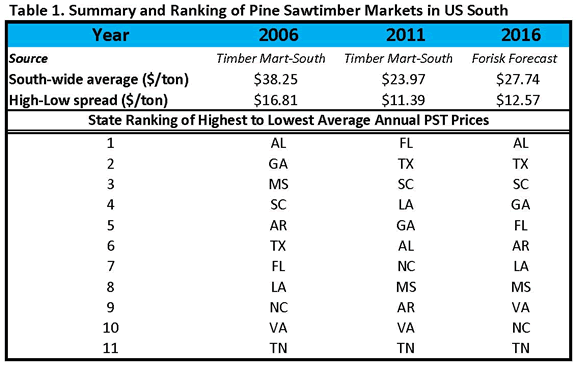When analyzing timber markets or wood baskets, paranoia regarding stumpage price data may serve you well. The “paranoia” emphasizes the need to kick the tires on stumpage price data sets and the value of recognizing stumpage forecasts and other metrics as individual pieces of a complete analytic effort. Building a house requires more than a hammer. Successful analysts deploy a set of tools to measure (twice or more), test and analyze markets for wood and timberland (and everything else…)
Timber Prices and Forecasts
Why “paranoia” over timber prices? One, each stumpage price data set – no matter its source, perceived quality, depth and structure – reflects a (biased) sample that suffers from practical, unavoidable limitations when applied to statistical analysis. Two, stumpage prices cannot be generalized across markets. Stumpage prices reflect a snapshot of uniquely local circumstances. Analyzing timber markets for investment purposes is a situational exercise.
Consider the disparity of historic and forecasted pine sawtimber prices across markets in the US South over time (Table 1). The price ranges (High-Low spread) across states in the past translate into broad ranges of estimated prices across states in the future. When applying third-party stumpage price data, we want to know, for example, (1) how well the price series reflects realized changes over time and (2) how well the series reflects price levels over time. These are two different questions that speak to the coverage, consistency and biases imbedded in the data.

What about stumpage forecasts? Forecasting helps identify relationships in historical data to infer future conditions. A forecast tells a story, a view of how the market functions. Since stumpage forecasts could compound the limitations of stumpage price data, perhaps forecasting is a fool’s errand. However, in practice, it’s a disciplined analytic exercise to test ideas, data and assumptions. Properly collecting and understanding the strengths and limitations of the data are as important as any aspect. Without testable, useful, reliable data, quantitative analysis would suffer and, once exposed, wither in a sea of scornful questions.
Wood Demand or Utilization?
As a timberland investor, would you prioritize high volume markets (with lots of mills demanding lots of wood) or high utilization (where mills run at near capacity)? As a wood user looking to locate a new facility, which would you prioritize? What have we learned from evaluating over 300 markets and teaching over two dozen workshops?
- Low demand is associated with lower prices, regardless utilization. We observe this across markets and forest product types. For both timberland investors and wood users, low volume markets correspond to high risk. Typically, demand trumps utilization when investigating wood raw materials.
- Demand, utilization and prices are all incomplete metrics when used independently. High demand (volume) can, at any given time, correspond with low, market level utilization, and vice versa. And high prices can easily correspond with low volume. Selling the highest priced sawlogs in the free world into a market that consumes seven tons per year is not a business; it’s a hobby.
- Timber market metrics temporarily and imperfectly quantify ambiguity. What happens as we evaluate different types of wood using facilities and technologies? What happens if we assess states individually or carve out firm or tract specific markets? How do these metrics look over time?
Implications for Investors
Educate yourself. Timber investors can reduce risk and maximize return opportunities with a clear understanding of how to assess markets themselves or how to evaluate market analyses someone else does on their behalf (or both). In August in Atlanta, we will offer our “Timber Market Analysis” course for the seventh year running to work with analysts and investors in a hands-on environment. The popularity and strength of educational opportunities such as this reinforce the common “paranoia” investors feel to “know what’s knowable” and use available information to tease out useful insights and identify red flags.
This content may not be used or reproduced in any manner whatsoever, in part or in whole, without written permission of LANDTHINK. Use of this content without permission is a violation of federal copyright law. The articles, posts, comments, opinions and information provided by LANDTHINK are for informational and research purposes only and DOES NOT substitute or coincide with the advice of an attorney, accountant, real estate broker or any other licensed real estate professional. LANDTHINK strongly advises visitors and readers to seek their own professional guidance and advice related to buying, investing in or selling real estate.










Add Comment